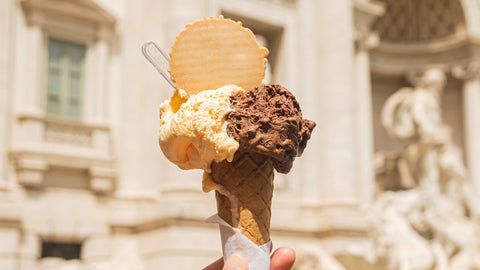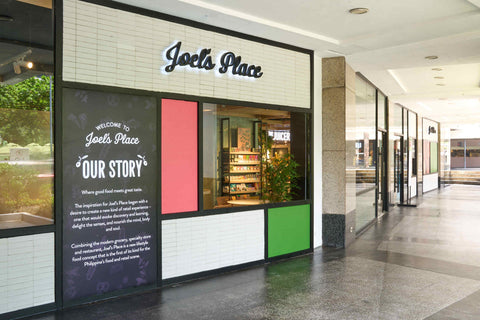It was every solo traveler’s nightmare: here I was at Rome’s Fiumicino airport, after having exchanged my last few euros for a cone of Venchi’s pistachio and gianduja gelato. After taking a snap of my last sweet treat, I realized that my passport was missing from my bag.
After frantically patting myself down as if that would magically make it appear, I retraced my steps to my last location—now with melty gelato in hand. In the middle of rushing up an escalator, I took a lick of gelato and caught myself pausing to think, wow, this is delicious. Even in a stressful situation—or maybe because of it—I found satisfaction in the cold, creamy treat.
As I approached the airport dining area, I caught a glimpse of my pink passport case; my earlier table hadn’t been bussed. Cue a huge sigh of relief. I sunk into the seat to catch my breath and finally finish my cone. Well, that was fun, I thought to myself as I got up (passport now securely in hand), headed to my boarding gate, and started my 10,389-kilometer commute home.
I spent 13 days in Rome, and I was dead set on making it, first and foremost, a food trip. In the weeks leading up to the trip, I dreamt of cacio e pepe, prosciutto crudo, burrata pizza, tiramisu, and, of course, gelato. I would have to travel over 15 hours to eat gelato in the winter, but gelato—all iterations of it—had travelled farther and longer to meet me in Rome.
Travelling back in time, the earliest recorded frozen desserts date back to 3000 BC when Asian cultures first mixed snow with milk and spices. Archeological evidence suggests that the pharaohs of ancient Egypt also served crushed ice with fruit juice to their guests. The Persians enjoyed sharbat, a cordial cooled with mountain snow, as far back as 550 BC, before it spread to China and the Middle East. It is believed that Arab conquerors introduced sharbat to Sicily, collecting snow from Mount Etna, the island’s highest peak. Eventually, Italians began gathering snow from Mounts Etna and Vesuvius and topping them with honey.
My first taste of Italian gelato was from a nondescript café in a piazza near my hotel in Monti. Still afraid of wandering too far on my own, I pinned the closest square on Google Maps and put my faith in modern-day GPS to lead the way. It was my second day, and Rome was louder, busier, and grittier than I had expected. Though it eventually won me over, the first few days felt unfamiliar and overwhelming. But the piazza was small and charming; the café owner a friendly, spirited lady; and the experience of eating a cup of pistachio and Stracciatella gelato al fresco as idyllic as I had imagined an Italian vacation to be.
My next gelato runs were more intentional, pinning gelaterias that were farther away from my hotel. At The Gelatist, they served an iteration of pistachio that was blended with Sicilian oranges, which I partnered with salted peanuts; it was too sweet for me, but I appreciated the variety to my favorite flavor. At Corona Gelateria, I tried the pistachio and panettone flavors topped with crema; a little too indulgent, but delicious, nonetheless. The Nicciola and pistachio cone I had at Gelateria S.M. Maggiore was the best I had; no wonder the store was always packed when I passed by.

Next to my list of the city’s highlights—the Colosseum, Trevi Fountain, the Spanish Steps—I took note of nearby trattorias and gelaterias; in every historical stop, there was also a stop for gelato. On my way to these spots, I entered thrift shops, vintage shops, paper stores, candle stores, and one Finnish design store. I stopped to listen to street musicians, sat at a nearby park to stare at the Victor Emmanuel II monument, and took a million photos of a riverbank that was ethereal in the winter light. As time passed, I explored more bravely, allowing my curiosity to lead me on unexpected detours, trusting that my phone would get me back on track if I lost my way. This was how I explored Rome.
During the Renaissance, the Medicis—Florence’s ruling family—held a contest for the best-frozen dessert, where merchant Cosimo Ruggieri’s concoction of ice, fruit juice, and sugar—a modern-day sorbetto—took first place. Caterina de Medici was convinced it could rival the desserts of France, and she took Ruggieri to France to make it for her wedding to the future King.
In the late 1500s, the same Medici family commissioned artist Bernardo Buontalenti to prepare a feast for the visiting King of Spain. He prepared a creamy frozen dessert flavored with bergamot, orange, and lemon—something closer to the gelato we have today.
In the 1600s, King Louis XIV of France appointed Sicilian chef Francesco Procopio dei Coltelli to make gelato for his court. The chef then opened Café Procope in Paris in 1684, where he served gelato to the Parisian elites, later including Voltaire and Rousseau. His café popularized gelato in France and eventually most of Europe.
A week into my trip, I was fully smitten with Rome, and confident enough that I decided to walk 45 minutes from Monti to Trastevere for lunch. Once again, I pinned a restaurant and gelateria—Trattoria Da Enzo and Otaleg—as my guide. Falling in line at the trattoria, I met Qin, another woman traveling alone. We chatted and realized that if we shared a table, we’d get to try two appetizers instead of one—a no-brainer. We shared a fried artichoke and polpette. I finally had my cacio e pepe; she had carbonara. Before parting ways, we passed by Otaleg to get my gelato fix. Pistachio, of course, this time with mascarpone and ricotta.
This Italian food trip was the most adventurous I’ve felt in a while, wandering around a city halfway across the world, doing things I never thought I’d do—celebrating papal mass at St Peter’s Basilica, walking the Colosseum alone on New Year’s Eve, having lunch with a stranger. I remember thinking how brave the voyagers of old were. With two smartphones, roaming data, a pocket wifi, a power bank, and Google Maps, I still felt nervous exploring a new place. I couldn’t imagine sailing the seas at a time when I was told I could fall off the earth if I leaned a little too far to the left.
There are other theories on how frozen desserts came to Europe. One says that Venetian explorer Marco Polo brought it back after traveling to China; another claims that Alexander the Great loved sharbat so much that he brought it back to Greece from Persia. I doubt that these men set sail to find frozen treats, but it was in the following of their curiosities, in their explorations, that other substantial discoveries were made.
It's in the detours and the winding back alleys that hidden gems are found. After all, it was the quest to see the world that gave us gelato.





